Employee Engagement
In order to solve the business problem of staff turnover, low productivity and low innovation, a solution emerged within management theory: employee engagement. It was first introduced as personnel engagement in academic literature in 1990[1], introducing a concept that added the commitment and involvement of employees to the then already established term of job satisfaction. An American analytics and advisory firm, Gallup, then created an employee engagement questionnaire and popularised the term in the 1990s. But whilst employee engagement has been around for three decades, the concept is now more popular than ever. There are dozens of survey providers that let HR professionals and organisational leadership assess the status of engagement within their company, as it is closely linked to productivity, revenue, and employee turnover.
(Sign up to trustxp.com to get updates on the progress we make in the field and get access to employee trust surveys.)
There are many organisations and researchers who created definitions of employee engagement. Kevin Kruse, author of the book Employee Engagement 2.0, defines employee engagement as ‘the emotional commitment the employee has to the organisation and its goals’.[2] A high emotional commitment will make the employee work overtime without having to ask, thus she will be more productive; and the individual will be happier at work, thus lowering employee turnover. The employee will be so committed that they will go above and beyond to ensure peak performance. No wonder organisations want to know everything about it.
Employee engagement has contributed significantly to the awareness of the importance of treating employees properly. The notion that happy employees will do a better job cannot be denied. There is also no doubt that employee engagement has helped to improve workplaces around the world. However, there still is a world to gain.
Employees are often broken into three categories when employee engagement is assessed[3]:
- Engaged
- Disengaged
- Actively disengaged

A worldwide study conducted by Gallup in 2017 showed that only 15% of employees are engaged at work,[4] this being up from 13% in 2013.[5] The same study conducted in the US returns results that are significantly higher, with percentages in the low 30’s.[6] Nevertheless, even in the US , it should come as no surprise that with such a low ‘engagement’ at work, there is an enormous waste of potential, both to the individuals and the organisations employing them. In times where employees are seen as assets, the classic economist would say that 13-15%, or even 30-34%, is a low utilisation rate. So, whilst employee engagement has been studied and actively promoted for 30 years, how come employee engagement is still at such a low level?
There are two main issues with the employee engagement approach when trying to identify reasons for performance below the organisational potential:
Employee engagement is not a leading, but a lagging indicator. A leading indicator is a factor that changes before other factors will. It can be used as a predictor of future performance. An example would be a person who starts going to the gym to become stronger: The fact that she goes to the gym three times per week, the leading indicator, will eventually result in a stronger and healthier person, the lagging indicator. If one measured how strong and healthy the person is, that would provide valuable information. However, it is more useful to know what contributed to the individual becoming stronger and healthier: going to the gym three times per week.
The way HR departments and organisational leaders treat employee engagement is similar. By itself, putting a number on employee engagement can act as a leading indicator for future organisational performance, such as revenue growth and innovation. Because, as we’ve established, more engaged personnel will essentially work harder. But the question remains, what makes an employee engaged? Why is it hard to motivate employees? Why do people leave their manager and not their job? And why is it that some organisations perform better than others? Why does it seem that no single perk will ever be enough to retain our workforce? Why do my employees stay in sick? How can I get my employees inspired? And why don’t they go the extra mile? Why are my employees unengaged? Or why do employees, at all levels of the organisation, from CEO to the mail man, want to contribute to the organisation?
Learn more about Employee Trust for a more compassionate approach to employee engagement.
[1] Kahn, William A (1990). “Psychological Conditions of Personal Engagement and Disengagement at Work” (PDF). Academy of Management Journal. 33 (4): 692–724.
[2] https://www.forbes.com/sites/kevinkruse/2012/06/22/employee-engagement-what-and-why/#6d995ce27f37
[3] https://www.linkedin.com/pulse/three-types-employees-engaged-actively-disengaged-ush-dhanak/
[4] https://www.gallup.com/workplace/238079/state-global-workplace-2017.aspx
[5] https://news.gallup.com/reports/178514/state-american-workplace.aspx
[6] https://news.gallup.com/poll/241649/employee-engagement-rise.aspx
